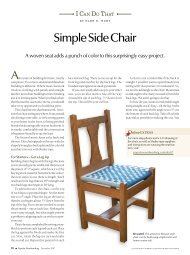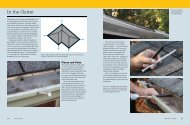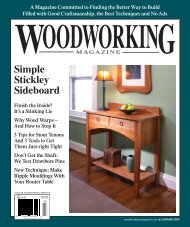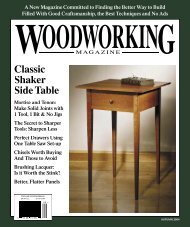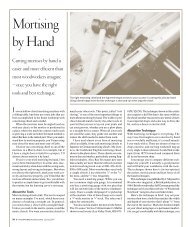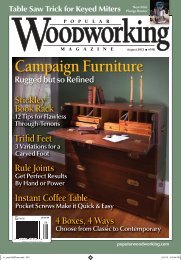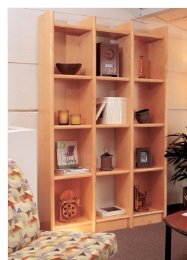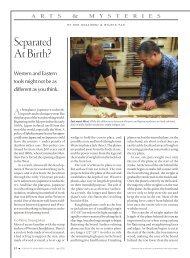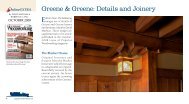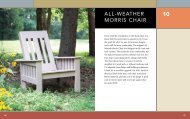Gluing up Flat PanelsThree easy steps – joint, glue and clamp – help you create perfect panels.WWood panels are an essential component inmaking almost every piece of furniture. While aflat panel less than 6" wide can be made by simplycrosscutting a board, a panel wider than thatwill require gluing a few boards together edgeto edge. Keeping those panels flat, straight andattractive is easily learned and will make all ofyour projects much more successful.First let’s get rid of a common myth: To makesure a panel stays flat, it’s not necessary to ripthe individual boards to 2" or 3" widths and thenreglue them. All this does is create more workand an ugly panel.Wood moves primarily because of changes inmoisture content. After being felled and cut, thewood from a tree slowly acclimates to its environmentas the moisture in the wood evaporates.Because of the shape and orientation of the fibersin a board, some will shrink more than others.Even when kiln-dried and assembled into a project,lumber will continue to react to changes in humidityby cupping and warping. The illustration(below) shows how wood will move as it dries andshould help you choose the right orientation ofgrowth rings. A trick is to try to leave the wood’sheartwood side showing on your panels.Proper preparation, technique and tools are all required to make a perfectly flat panel.PHOTO BY AL PARRISHFresh cutAfter dryingThe first step in gluing up a flat panel isreading the wood. The end view of a board (orlog, as above) shows the different shrinkagepattern for different cuts of lumber. Knowinghow your lumber will react to humidity changeswill help you with your panel layouts.Proper wood preparation also can help youavoid warping. When planing boards to final thickness,remove material evenly from both sides toallow grain tension in the board to remain stable.When you rough-cut your wood, leave theboards a little long and wide (so the panel glueupis 1" oversize in both directions). Cut them tofinished size after your glue-up. This lets you cutaround imperfections near the edges.Also, pay careful attention to the appearanceof each board. Even though we have to use morethan one board to make our panels, we want tomake the panels look like they’re still one piece.Matching the cathedrals or the straight-grain patternsat the joint (as well as matching the color ofthe wood) will make for a better-looking finishedpanel. Try to get all of your panel pieces from asingle board length. Color- and grain-matchingis much easier then.Once you’ve determined where your jointsshould occur, you must make those edges mateperfectly. The jointer is designed to produce anedge that is perpendicular to the face of the board.But if the fence is slightly off, the edge will be,too. Each board needs to be flat and have at leastone perpendicular edge (interior boards need two)to achieve a flat panel. The bottom left photo onpage 23 shows a trick to make sure your boardsmeet flat at the edge every time.Now let’s talk about glue – either yellow orwhite glue will work fine for a simple edge joint.Glue isn’t intended to fill gaps between two piecesof wood, but rather to bond two pieces together.Only use enough glue – about .001" thick – toform a locking layer between the two surfaces.Too much glue creates a weak joint. Insufficientor partially dried glue results in inadequate bondingstrength.22 ■ woodworking magazine Autumn 2004
Now you’re ready to glue up your panel, butthere’s still lots to know. Let’s start with clampingpressure and proper clamp orientation. Clampsare designed to produce tremendous pressure,and that’s great, but it doesn’t mean you shoulduse that pressure to force an open joint closedduring glue-up. If you have to do that then youredges weren’t properly joined to begin with. Evenwith a perfect joint, applying maximum clamppressure can cause the panel to twist.You should be able to close the joint usingonly hand pressure. A slight gap at the center ofthe joint, called a “sprung” joint, is acceptable(some woodworkers say preferable). This addstension at the ends of the joint, which can separateas the wood dries. But if the gaps occur atthe ends of the panel, problems with the jointpulling open later could occur.With the glue properly applied, it’s time toadd clamps. No matter what type of clamp youSplitSapKnotThis three-board panel (on top) shows nicelymatching grain patterns, making the transitionbetween the boards invisible. The three boardsunderneath the panel exhibit some problems thatcan arise in matching grain.are using, it’s good practice to alternate the barsabove and below the panel. You should also spacethem about 6" - 8" apart on panels made with narrowboards and farther apart (up to 12") on panelsmade with wider boards. Clamping pressureradiates out from the clamp face at a 45° angle.That radiant pressure should overlap at the gluejoint. The order that clamps are applied will helpas well. (See photo at bottom right.)If you’re gluing up a panel with many boards(such as a kitchen tabletop with six boards) youcan make the glue-up much easier by being a littlepatient. First glue up three two-board panels, thenjoin those three panels together. Aligning twoglue joints is much easier than aligning five.Another suggestion during clamping is to useyour clamps’ bars to keep the panel flat. With thepanel resting against the bar, the bar adds support(from both sides) to keep the panel flat. But whenyou use your clamps in this manner, the steel ofthe bar (if not plated) can react to the glue andleave black marks on your panel. Either slide apiece of paper between the clamp and glue jointor make sure you use clamps with plated bars.Apply enough clamp pressure so the boardsdon’t slide around at the joint. You likely will haveto apply some side pressure to slide the boards.If you need extra leverage to level up the joints,twist the unclamped ends of the boards. Whenthe seam is flush between the clamp heads, applyenough clamping pressure to make glue squeezeout of the joint and close the gap to about .001"wide. Again, don’t overtighten the clamp. If you’regetting good glue squeeze-out and the joint istight, that’s when it’s time to stop.About that excess glue: Before you set thepanel aside to dry (that’s at least 30 minutes beforeyou can take the clamps off and an hour beforeyou should apply pressure to the joint), take adamp cloth (not wet) and wipe along the joint inshort swipes, cleaning off the glue completely.One myth is that adding water to a glue jointwill dilute the glue, weakening the joint – notso. The amount of water involved in the cleaningprocess will have no affect on joint strengthand save a lot of torn fibers if you try to removethe dried glue from the panel later.Once the clamps are removed, it should onlybe necessary to plane or sand the joint lightly tosmooth it flush on your panel.And that’s all there is to making perfect flatpanels. It’s the backbone of any woodworkingproject and when done correctly, it’s also one placeto let the beauty of the wood show through. WM– David ThielA good glue joint starts with a thin, even coat ofglue. Glue will penetrate wood until it starts tocure, then it only lays on the surface of the wood.So for fast glue-ups, putting glue on one surfaceof the joint is adequate. For multiple or long (24")joints, spread glue on both surfaces.Clamp pressureradiates outat 45° toclamp headsFingercheck2°With your finished faces showing, markone board with an “I” and the otherboard with an “O.” Also mark the jointon both boards to avoid confusion. Take the board marked with an “I” andplace that marked face “in,” against the jointer fence, and make your pass.Take the “O” board and set it with that face “out,” away from the jointerfence, and make your pass. Even if your jointer fence was out by 2° or 3°, byproducing complementary angles at the joint you will have a square joint.And it works for as many boards as necessary to make up your panel. Theinset photo shows the flat panel with the 2° offset at the joint.When clamping, it’s easiest to start at the center of the joint with yourfirst clamp. As you apply pressure, make sure that the faces are aligned asperfectly as possible by running your finger across the joint. Wipe off theglue with a wet rag. You want to remove the glue entirely, not push the gluefurther into the grain, so wipe well.woodworking-magazine.com ■ 23



